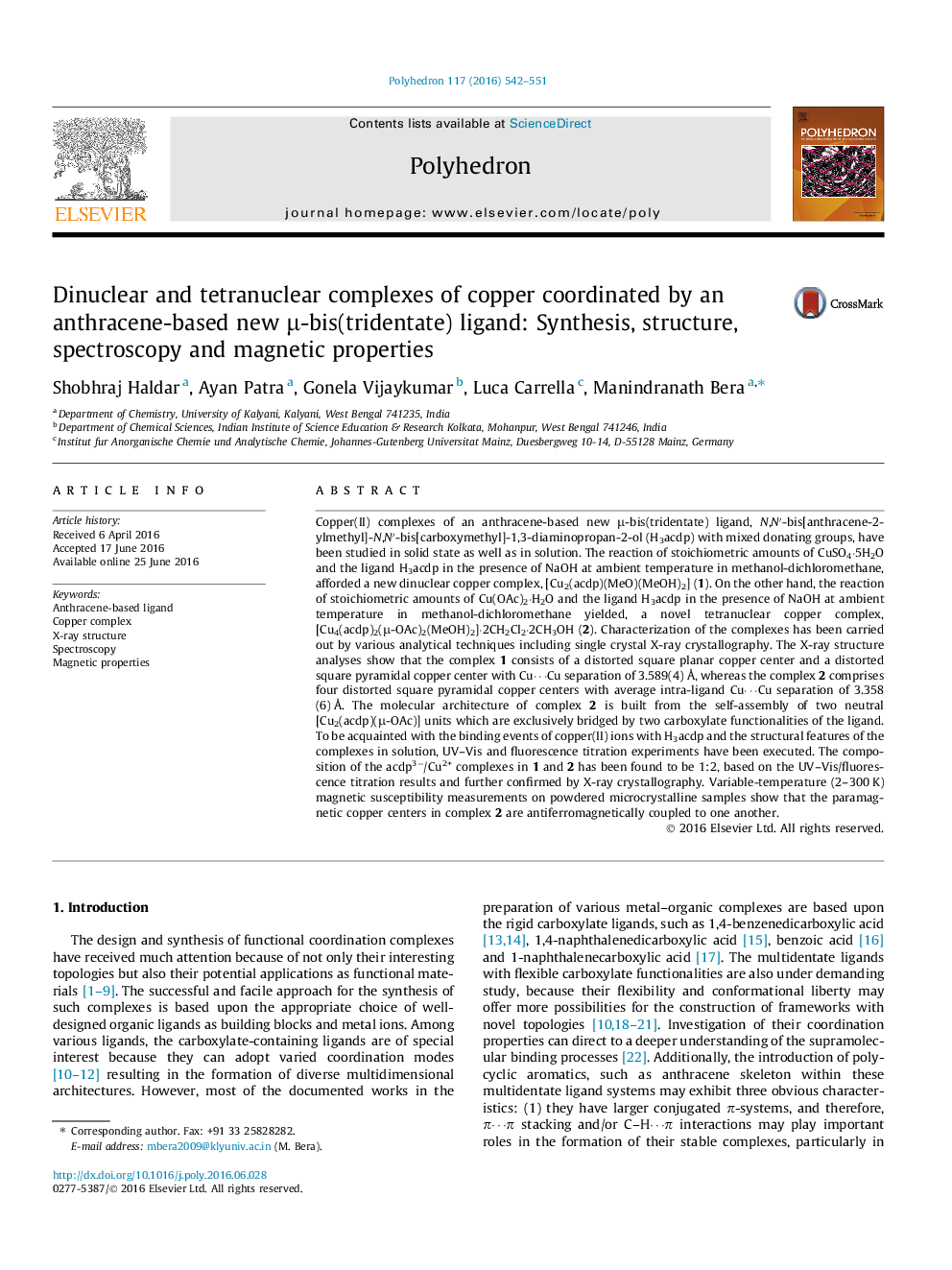| کد مقاله | کد نشریه | سال انتشار | مقاله انگلیسی | نسخه تمام متن |
|---|---|---|---|---|
| 1336238 | 1500223 | 2016 | 10 صفحه PDF | دانلود رایگان |

Copper(II) complexes of an anthracene-based new μ-bis(tridentate) ligand, N,N′-bis[anthracene-2-ylmethyl]-N,N′-bis[carboxymethyl]-1,3-diaminopropan-2-ol (H3acdp) with mixed donating groups, have been studied in solid state as well as in solution. The reaction of stoichiometric amounts of CuSO4·5H2O and the ligand H3acdp in the presence of NaOH at ambient temperature in methanol-dichloromethane, afforded a new dinuclear copper complex, [Cu2(acdp)(MeO)(MeOH)2] (1). On the other hand, the reaction of stoichiometric amounts of Cu(OAc)2·H2O and the ligand H3acdp in the presence of NaOH at ambient temperature in methanol-dichloromethane yielded, a novel tetranuclear copper complex, [Cu4(acdp)2(μ-OAc)2(MeOH)2]·2CH2Cl2·2CH3OH (2). Characterization of the complexes has been carried out by various analytical techniques including single crystal X-ray crystallography. The X-ray structure analyses show that the complex 1 consists of a distorted square planar copper center and a distorted square pyramidal copper center with Cu⋯Cu separation of 3.589(4) Å, whereas the complex 2 comprises four distorted square pyramidal copper centers with average intra-ligand Cu⋯Cu separation of 3.358(6) Å. The molecular architecture of complex 2 is built from the self-assembly of two neutral [Cu2(acdp)(μ-OAc)] units which are exclusively bridged by two carboxylate functionalities of the ligand. To be acquainted with the binding events of copper(II) ions with H3acdp and the structural features of the complexes in solution, UV–Vis and fluorescence titration experiments have been executed. The composition of the acdp3−/Cu2+ complexes in 1 and 2 has been found to be 1:2, based on the UV–Vis/fluorescence titration results and further confirmed by X-ray crystallography. Variable-temperature (2–300 K) magnetic susceptibility measurements on powdered microcrystalline samples show that the paramagnetic copper centers in complex 2 are antiferromagnetically coupled to one another.
Two new, a dinuclear and a tetranuclear copper complexes supported by an anthracene-based μ-bis(tridentate) ligand have been synthesized and characterized. In solution, the ligand shows excellent binding-cum-chelating ability towards copper(II) ions and the binding events have been evaluated by a combined approach of UV–Vis and fluorescence spectroscopic techniques. The UV–Vis and fluorescence titration spectra confirm the 1:2 binding model between the ligand and copper(II) which have been further supported by single crystal X-ray structures of the complexes. Variable-temperature (2–300 K) magnetic susceptibility measurements of the tetranuclear complex reveal that the copper centers are antiferromagnetically coupled.Figure optionsDownload as PowerPoint slide
Journal: Polyhedron - Volume 117, 15 October 2016, Pages 542–551